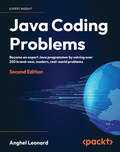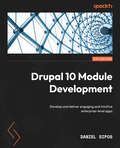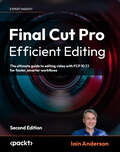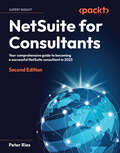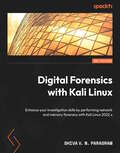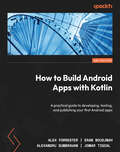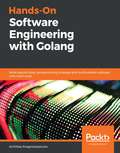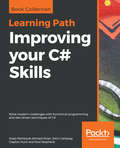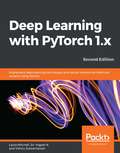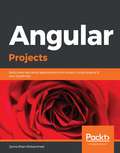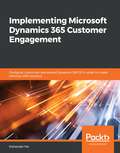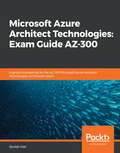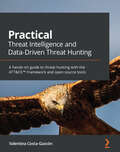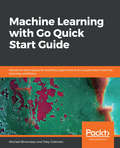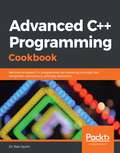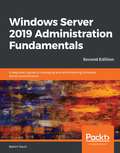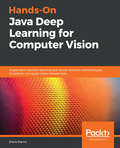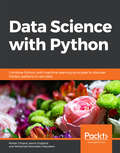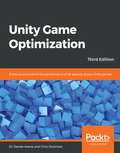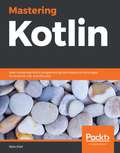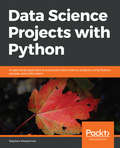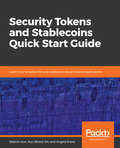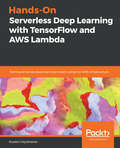- Table View
- List View
Java Coding Problems: Become an expert Java programmer by solving over 250 brand-new, modern, real-world problems
by Anghel LeonardStay on top of the new Java features (up to JDK 21) and find efficient solutions for your programming woes. With over 250 problems and solutions, you'll learn new ways to deal with real-world coding tasks and answers to common interview questions. Purchase of the print or Kindle book includes a free PDF eBookKey FeaturesSolve Java programming challenges and get interview-ready with the power of modern Java 21Test your Java skills using language features, algorithms, data structures, and design patternsExplore tons of examples, all fully refreshed for this edition, meant to help you accommodate JDK 12 to JDK 21Book DescriptionThe super-fast evolution of the JDK between versions 12 and 21 has made the learning curve of modern Java steeper, and increased the time needed to learn it. This book will make your learning journey quicker and increase your willingness to try Java’s new features by explaining the correct practices and decisions related to complexity, performance, readability, and more. Java Coding Problems takes you through Java’s latest features but doesn’t always advocate the use of new solutions — instead, it focuses on revealing the trade-offs involved in deciding what the best solution is for a certain problem. There are more than two hundred brand new and carefully selected problems in this second edition, chosen to highlight and cover the core everyday challenges of a Java programmer. Apart from providing a comprehensive compendium of problem solutions based on real-world examples, this book will also give you the confidence to answer questions relating to matching particular streams and methods to various problems. By the end of this book you will have gained a strong understanding of Java’s new features and have the confidence to develop and choose the right solutions to your problems.What you will learnAdopt the latest JDK 21 features in your applicationsExplore Records, Record Patterns, Record serialization and so onWork with Sealed Classes and Interfaces for increasing encapsulationLearn how to exploit Context-Specific Deserialization FiltersSolve problems relating to collections and esoteric data structuresLearn advanced techniques for extending the Java functional APIExplore the brand-new Socket API and Simple Web ServerTackle modern Garbage Collectors and Dynamic CDS ArchivesWho this book is forIf you are a Java developer who wants to level-up by solving real-world problems, then this book is for you. Working knowledge of the Java programming language is required to get the most out of this book
Drupal 10 Module Development: Develop and deliver engaging and intuitive enterprise-level apps, 4th Edition
by Daniel SiposBuild and customize powerful Drupal modules to extend your website's functionalities with this comprehensive guidePurchase of the print or Kindle book includes a free PDF eBookKey FeaturesExplore the new features and improved capabilities of Drupal 10 coreDiscover Drupal APIs and elevate your proficiency by leveraging PHP codingImplement efficient data management and data security by creating dedicated modulesBook DescriptionEmbark on a journey of Drupal module development with the latest edition of this must-have guide written by Daniel Sipos – a Drupal community member! This fourth edition is meticulously revised to cover the latest Drupal 10 enhancements that will help you build custom Drupal modules with an understanding of code deprecations, changing architecture, data modeling, multilingual ecosystem, and so on.You'll begin with understanding the core components of Drupal 10 architecture, discovering its subsystems and unlocking the secrets of creating your first Drupal module. Further, you'll delve into Drupal logging and mailing systems, creating theme hooks, and rendering a layout. As you progress, you'll work with different types of data storage, custom entities, field types, and work with Database APIs for lower-level database queries. You'll learn to reap the power of JavaScript and ensure that your code works seamlessly on multilingual sites. You'll also learn to create custom views, automate tests for your functionalities, and write secure code for your Drupal apps.By the end of this book, you'll have gained confidence in developing complex modules that can solve even the most complex business problems and might even become a valuable contributor to the Drupal community!What you will learnGain insight into the Drupal 10 architecture for developing advanced modulesMaster different Drupal 10 subsystems and APIsOptimize data management by modeling, storing, manipulating, and processing data efficientlyPresent data and content cleanly and securely using the theme systemUnderstand helpful functions while dealing with managed and unmanaged filesEnsure your Drupal app has business logic integrity with automated testingImplement secure coding in DrupalWho this book is forIf you are a Drupal developer looking to create custom modules for Drupal sites and cater business needs, this book is the one-stop solution for you. Drupal 10 Module Development will be helpful for Drupal site builders and PHP developers with basic object-oriented programming skills, looking to upskill themselves in Drupal module development. A basic working experience with Symfony will be helpful but not mandatory.
Final Cut Pro Efficient Editing: The ultimate guide to editing video with FCP for Mac, 2nd Edition
by Iain AndersonUnlock the hidden gems of video editing with Iain Anderson, Apple Certified TrainerBonus 1: Get the Ultimate FCP Keyboard Shortcut Cheat-Sheet for maximum speed!Bonus 2: Get Free Digital Updates for your book, regardless of the format you purchase!Key FeaturesCovers the newest FCP features (v10.6.6, June 2023) and is extensively tested with the latest bug fixes.Easy-to-follow and well-organized, with clear explanations and helpful tips for beginners and experienced users.Updated with the latest features, including a new 360 Workflows Appendix, Object Tracking, advanced color correction techniques, and much more.Book DescriptionElevate your video editing skills with Final Cut Pro, the ultimate tool for efficient and professional editing, offering powerful new features to enhance your workflow and give your videos a stunning look.The second edition of this comprehensive guide covers exciting new features in FCP, teaching you how to streamline your workflow with customizable workspaces, shortcuts, and advanced trimming tools. Explore best-in-class titles and a comprehensive suite of visual effects in Final Cut Pro for dynamic videos, create a great-sounding mix with Final Cut Pro's audio tools, and utilize the magnetic timeline, multicam editing, and advanced color correction for every project.Whether you're creating content for social media, YouTube, or Hollywood, Final Cut Pro Efficient Editing, Second Edition is your ultimate guide to professional video editing. Get your copy today and take your video editing skills to the next level.What you will learnOrganize and manage media from multiple sourcesEdit and manipulate video with an intuitive interface and powerful toolsStreamline your workflow with customizable workspaces and keyboard shortcutsSync and edit multicam interviews with ease and learn advanced trimming techniquesUse advanced audio and color grading tools to achieve a professional-quality finishWork with other editors using the built-in collaboration toolsCreate stunning visual effects and complex motion graphics titlesExport video projects in a variety of formats for delivery to multiple platforms and user devicesWho this book is forThis book is designed to help everyone: creative professionals, anyone new to video editing, and existing editors switching from other video editing systems to Final Cut Pro or stepping up from iMovie.Whether you are a beginner or a professional, you'll find this FCP book highly valuable. All you need to get started is a basic familiarity with macOS.
Final Cut Pro Efficient Editing: The ultimate guide to editing video with FCP 10.7.1 for faster, smarter workflows
by Iain AndersonUnlock the hidden gems of video editing with Iain Anderson, Apple Certified Trainer Bonus 1: Get the Ultimate FCP Keyboard Shortcut Cheat-Sheet for maximum speed! Bonus 2: Get Free Digital Updates for your book, regardless of the format you purchase!Key FeaturesCovers the newest features for FCP 10.7.1 along with expert tips, step-by-step tutorials, and advanced techniquesEasy-to-follow and well-organized, with clear explanations and helpful tips for beginners and experienced usersUpdated with the latest features, including a new 360° Workflows Appendix, Object Tracking, advanced color correction techniques, and much moreBook DescriptionElevate your video editing skills with Final Cut Pro 10.7.1, the ultimate tool for efficient and professional editing, offering powerful new features to enhance your workflow and give your videos a stunning look. The second edition of this comprehensive guide covers exciting new features in FCP, teaching you how to streamline your workflow with customizable workspaces, shortcuts, and advanced trimming tools. Explore best-in-class titles and a comprehensive suite of visual effects in Final Cut Pro for dynamic videos, create a great-sounding mix with Final Cut Pro's audio tools, and utilize the magnetic timeline, multicam editing, and advanced color correction for every project. Whether you're creating content for social media, YouTube, or Hollywood, Final Cut Pro Efficient Editing, Second Edition is your ultimate guide to professional video editing. Get your copy today and take your video editing skills to the next level.What you will learnOrganize and manage media from multiple sourcesEdit and manipulate video with an intuitive interface and powerful toolsStreamline your workflow with customizable workspaces and keyboard shortcutsSync and edit multicam interviews with ease and learn advanced trimming techniquesUse advanced audio and color grading tools to achieve a professional-quality finishWork with other editors using the built-in collaboration toolsCreate stunning visual effects and complex motion graphics titlesExport video projects in a variety of formats for delivery to multiple platforms and user devicesWho this book is forThis book is designed to help everyone: creative professionals, anyone new to video editing, and existing editors switching from other video editing systems to Final Cut Pro or stepping up from iMovie. Whether you are a beginner or a professional, you'll find this FCP book highly valuable. All you need to get started is a basic familiarity with macOS.
NetSuite for Consultants: Your comprehensive guide to becoming a successful NetSuite consultant in 2023, 2nd Edition
by Peter RiesGuide clients through a NetSuite implementation with the latest features in 2023 including gathering requirements, setting up the basics, creating custom automations, and importing data with SuiteQLKey FeaturesPick up the best ways to identify a client's needs by asking the right questions in the initial interviews.Explore the new features in NetSuite 2023, including the Supply Chain Control Tower for managing inventory and gathering performance reports.Avoid pitfalls and get the implementation right first time by following the advice of a Consulting Technical Director at Oracle NetSuite.Book DescriptionERP and CRM consultants can effectively implement NetSuite for a client organization with the aid of NetSuite for Consultants, revised with the latest features and best practices for NetSuite 2023. After reading this book, you'll have a thorough understanding of how to configure the NetSuite ecosystem for any business. You'll learn how to apply new features such as the Manufacturing Mobile application, NetSuite budgeting features, and tools for handling rebates and trade promotions. This edition also includes expanded coverage of technical topics such as SuiteQL and the SuiteTalk REST API. Understanding what a business requires is a crucial first step toward completing any software product deployment, and this NetSuite guide will teach you how to ask meaningful questions that ascertain which features, basic and new, you will need to configure for your client. Most importantly, you'll not only learn how to perform a NetSuite implementation; you'll also learn how to prepare clients to use the software confidently, which is the true test of a great consultant.What you will learnUnderstand the NetSuite ecosystem, including the platform and its primary modules, and associated featuresLearn how to gather and document requirements, including understanding an organization's industry, transactions, and peopleLearn about the methodologies that go into creating a project plan for a NetSuite implementationFulfill client requirements with expanded coverage on managing employees, customer projects, and budgetingDiscover how to create custom automations and perform data migration with SuiteQL scriptsPerform integrations with expanded coverage on how we use the REST API for business purposesRecognize the procedures for testing and developmentRefine your skills with NetSuite tips and tricks and make each implementation process a successWho this book is forThis book is aimed at new NetSuite consultants who are tasked with guiding an organization through their NetSuite implementation. To make the most out of this book, you are expected to have already completed the basic NetSuite Foundations training course.
Digital Forensics with Kali Linux: Enhance your investigation skills by performing network and memory forensics with Kali Linux 2022.x, 3rd Edition
by Shiva V. ParasramExplore various digital forensics methodologies and frameworks and manage your cyber incidents effectivelyPurchase of the print or Kindle book includes a free PDF eBookKey FeaturesGain red, blue, and purple team tool insights and understand their link with digital forensicsPerform DFIR investigation and get familiarized with Autopsy 4Explore network discovery and forensics tools such as Nmap, Wireshark, Xplico, and ShodanBook DescriptionKali Linux is a Linux-based distribution that's widely used for penetration testing and digital forensics. This third edition is updated with real-world examples and detailed labs to help you take your investigation skills to the next level using powerful tools.This new edition will help you explore modern techniques for analysis, extraction, and reporting using advanced tools such as FTK Imager, Hex Editor, and Axiom. You'll cover the basics and advanced areas of digital forensics within the world of modern forensics while delving into the domain of operating systems. As you advance through the chapters, you'll explore various formats for file storage, including secret hiding places unseen by the end user or even the operating system. You'll also discover how to install Windows Emulator, Autopsy 4 in Kali, and how to use Nmap and NetDiscover to find device types and hosts on a network, along with creating forensic images of data and maintaining integrity using hashing tools. Finally, you'll cover advanced topics such as autopsies and acquiring investigation data from networks, memory, and operating systems.By the end of this digital forensics book, you'll have gained hands-on experience in implementing all the pillars of digital forensics: acquisition, extraction, analysis, and presentation – all using Kali Linux's cutting-edge tools.What you will learnInstall Kali Linux on Raspberry Pi 4 and various other platformsRun Windows applications in Kali Linux using Windows Emulator as WineRecognize the importance of RAM, file systems, data, and cache in DFIRPerform file recovery, data carving, and extraction using Magic RescueGet to grips with the latest Volatility 3 framework and analyze the memory dumpExplore the various ransomware types and discover artifacts for DFIR investigationPerform full DFIR automated analysis with Autopsy 4Become familiar with network forensic analysis tools (NFATs)Who this book is forThis book is for students, forensic analysts, digital forensics investigators and incident responders, security analysts and administrators, penetration testers, or anyone interested in enhancing their forensics abilities using the latest version of Kali Linux along with powerful automated analysis tools. Basic knowledge of operating systems, computer components, and installation processes will help you gain a better understanding of the concepts covered.
How to Build Android Apps with Kotlin: A practical guide to developing, testing, and publishing your first Android apps, 2nd Edition
by Alex Forrester Eran Boudjnah Alexandru Dumbravan Jomar TigcalUnleash the power of Android programming to build scalable and reliable apps using industry best practicesPurchase of the print or Kindle book includes a free PDF eBookKey FeaturesBuild apps with Kotlin, Google's preferred programming language for Android developmentUnlock solutions to development challenges with guidance from experienced Android professionalsImprove your apps by adding valuable features that make use of advanced functionalityBook DescriptionLooking to kick-start your app development journey with Android 13, but don't know where to start? How to Build Android Apps with Kotlin is a comprehensive guide that will help jump-start your Android development practice. This book starts with the fundamentals of app development, enabling you to utilize Android Studio and Kotlin to get started with building Android projects. You'll learn how to create apps and run them on virtual devices through guided exercises. Progressing through the chapters, you'll delve into Android's RecyclerView to make the most of lists, images, and maps, and see how to fetch data from a web service. You'll also get to grips with testing, learning how to keep your architecture clean, understanding how to persist data, and gaining basic knowledge of the dependency injection pattern. Finally, you'll see how to publish your apps on the Google Play store. You'll work on realistic projects that are split up into bitesize exercises and activities, allowing you to challenge yourself in an enjoyable and attainable way. You'll build apps to create quizzes, read news articles, check weather reports, store recipes, retrieve movie information, and remind you where you parked your car. By the end of this book, you'll have the skills and confidence to build your own creative Android applications using Kotlin.What you will learnCreate maintainable and scalable apps using KotlinUnderstand the Android app development lifecycleSimplify app development with Google architecture componentsUse standard libraries for dependency injection and data parsingApply the repository pattern to retrieve data from outside sourcesBuild user interfaces using Jetpack ComposeExplore Android asynchronous programming with Coroutines and the Flow APIPublish your app on the Google Play storeWho this book is forIf you want to build Android applications using Kotlin but are unsure of how and where to begin, then this book is for you. To easily grasp the concepts in this book, a basic understanding of Kotlin, or experience in a similar programming language is a must.
How to Build Android Apps with Kotlin: A practical guide to developing, testing, and publishing your first Android apps
by Alex Forrester Eran Boudjnah Alexandru Dumbravan Jomar TigcalUnleash the power of Android programming to build scalable and reliable apps using industry best practices Purchase of the print or Kindle book includes a free PDF eBookKey FeaturesBuild apps with Kotlin, Google’s preferred programming language for Android developmentUnlock solutions to development challenges with guidance from experienced Android professionalsImprove your apps by adding valuable features that make use of advanced functionalityBook DescriptionLooking to kick-start your app development journey with Android 13, but don’t know where to start? How to Build Android Apps with Kotlin is a comprehensive guide that will help jump-start your Android development practice. This book starts with the fundamentals of app development, enabling you to utilize Android Studio and Kotlin to get started with building Android projects. You'll learn how to create apps and run them on virtual devices through guided exercises. Progressing through the chapters, you'll delve into Android's RecyclerView to make the most of lists, images, and maps, and see how to fetch data from a web service. You'll also get to grips with testing, learning how to keep your architecture clean, understanding how to persist data, and gaining basic knowledge of the dependency injection pattern. Finally, you'll see how to publish your apps on the Google Play store. You'll work on realistic projects that are split up into bitesize exercises and activities, allowing you to challenge yourself in an enjoyable and attainable way. You'll build apps to create quizzes, read news articles, check weather reports, store recipes, retrieve movie information, and remind you where you parked your car. By the end of this book, you'll have the skills and confidence to build your own creative Android applications using Kotlin.What you will learnCreate maintainable and scalable apps using KotlinUnderstand the Android app development lifecycleSimplify app development with Google architecture componentsUse standard libraries for dependency injection and data parsingApply the repository pattern to retrieve data from outside sourcesBuild user interfaces using Jetpack ComposeExplore Android asynchronous programming with Coroutines and the Flow APIPublish your app on the Google Play storeWho this book is forIf you want to build Android applications using Kotlin but are unsure of how and where to begin, then this book is for you. To easily grasp the concepts in this book, a basic understanding of Kotlin, or experience in a similar programming language is a must.
Hands-On Software Engineering with Golang: Move beyond basic programming to design and build reliable software with clean code
by Achilleas AnagnostopoulosExplore software engineering methodologies, techniques, and best practices in Go programming to build easy-to-maintain software that can effortlessly scale on demand Key Features Apply best practices to produce lean, testable, and maintainable Go code to avoid accumulating technical debt Explore Go's built-in support for concurrency and message passing to build high-performance applications Scale your Go programs across machines and manage their life cycle using Kubernetes Book Description Over the last few years, Go has become one of the favorite languages for building scalable and distributed systems. Its opinionated design and built-in concurrency features make it easy for engineers to author code that efficiently utilizes all available CPU cores. This Golang book distills industry best practices for writing lean Go code that is easy to test and maintain, and helps you to explore its practical implementation by creating a multi-tier application called Links 'R' Us from scratch. You'll be guided through all the steps involved in designing, implementing, testing, deploying, and scaling an application. Starting with a monolithic architecture, you'll iteratively transform the project into a service-oriented architecture (SOA) that supports the efficient out-of-core processing of large link graphs. You'll learn about various cutting-edge and advanced software engineering techniques such as building extensible data processing pipelines, designing APIs using gRPC, and running distributed graph processing algorithms at scale. Finally, you'll learn how to compile and package your Go services using Docker and automate their deployment to a Kubernetes cluster. By the end of this book, you'll know how to think like a professional software developer or engineer and write lean and efficient Go code. What you will learn Understand different stages of the software development life cycle and the role of a software engineer Create APIs using gRPC and leverage the middleware offered by the gRPC ecosystem Discover various approaches to managing package dependencies for your projects Build an end-to-end project from scratch and explore different strategies for scaling it Develop a graph processing system and extend it to run in a distributed manner Deploy Go services on Kubernetes and monitor their health using Prometheus Who this book is for This Golang programming book is for developers and software engineers looking to use Go to design and build scalable distributed systems effectively. Knowledge of Go programming and basic networking principles is required.
Improving your C# Skills: Solve modern challenges with functional programming and test-driven techniques of C#
by Ovais Mehboob Ahmed Khan John Callaway Clayton Hunt Rod StephensConquer complex and interesting programming challenges by building robust and concurrent applications with caches, cryptography, and parallel programming.Key FeaturesUnderstand how to use .NET frameworks like the Task Parallel Library (TPL)and CryptoAPIDevelop a containerized application based on microservices architectureGain insights into memory management techniques in .NET CoreBook DescriptionThis Learning Path shows you how to create high performing applications and solve programming challenges using a wide range of C# features. You’ll begin by learning how to identify the bottlenecks in writing programs, highlight common performance pitfalls, and apply strategies to detect and resolve these issues early. You'll also study the importance of micro-services architecture for building fast applications and implementing resiliency and security in .NET Core. Then, you'll study the importance of defining and testing boundaries, abstracting away third-party code, and working with different types of test double, such as spies, mocks, and fakes. In addition to describing programming trade-offs, this Learning Path will also help you build a useful toolkit of techniques, including value caching, statistical analysis, and geometric algorithms. This Learning Path includes content from the following Packt products:C# 7 and .NET Core 2.0 High Performance by Ovais Mehboob Ahmed KhanPractical Test-Driven Development using C# 7 by John Callaway, Clayton HuntThe Modern C# Challenge by Rod StephensWhat you will learnMeasure application performance using BenchmarkDotNetLeverage the Task Parallel Library (TPL) and Parallel Language Integrated Query (PLINQ)library to perform asynchronous operationsModify a legacy application to make it testableUse LINQ and PLINQ to search directories for files matching patternsFind areas of polygons using geometric operationsRandomize arrays and lists with extension methodsUse cryptographic techniques to encrypt and decrypt strings and filesWho this book is forIf you want to improve the speed of your code and optimize the performance of your applications, or are simply looking for a practical resource on test driven development, this is the ideal Learning Path for you. Some familiarity with C# and .NET will be beneficial.
Deep Learning with PyTorch 1.0 - Second Edition
by Sri. Yogesh K.This book is for data scientists and machine learning engineers who are looking to explore deep learning algorithms using PyTorch 1.x offerings. Those who wish to migrate to PyTorch 1.x will find this book insightful. Some knowledge of machine learning will be helpful. Working knowledge of Python programming is expected.
Angular Projects: Build nine real-world applications from scratch using Angular 8 and TypeScript
by Zama Khan MohammedUnderstand Angular web development by building real-world captivating applications exploring various web technologies and best practices Key Features Explore Angular's capabilities in building Web apps, mobile apps, and browser games Get to know Angular's latest features like Ivy renderer, Lazy loading and differential loading Build test-driven Angular applications using Jasmine and Jest frameworks Book Description Angular is one of the best frameworks, not only for building web applications, but also for building applications on other platforms such as desktop and mobile. It is packed with amazing web tools that allow developers to become more productive and make the development experience a happier one This book will be your practical guide when it comes to building optimized web apps using Angular. The book explores a number of popular features, including the experimental Ivy rendered, lazy loading, and differential loading, among others, in the projects. It starts with the basics of Angular and its tools, which will help you to develop and debug Angular applications. You will learn how to create an SPA using Angular Router, and optimize it by code splitting and Preloading Routes. We will then build a form-heavy application and make forms reactive by using Reactive Forms. After that, we will learn how to build a Progressive Web App, and a server-side rendering app, as well as a MonoRepo app. Furthermore, we will also dive into building mobile apps using Ionic and NativeScript. Finally, we end the book by creating a component library for our application using Angular CDK and then testing it. By the end of this book, you will know everything you need in order to get started with Angular and build a variety of applications. What you will learn Set up Angular applications using Angular CLI and Angular Console Understand lazy loading using dynamic imports for routing Perform server-side rendering by building an SEO application Build a Multi-Language NativeScript Application with Angular Explore the components library for frontend web using Angular CDK Scale your Angular applications using Nx, NgRx, and Redux Who this book is for The book is aimed at any JavaScript developers who want to start with Angular and become an expert in all the tools and the various use cases that they might deal with as an Angular expert. Whatever the case, a basic understanding of Angular is a plus but is not required. You should know the basics of developing web applications and have experience working with ES6 or TypeScript.
Implementing Microsoft Dynamics 365 Customer Engagement: Configure, customize, and extend Dynamics 365 CE in order to create effective CRM solutions
by Mahender PalGain hands-on experience working with the architecture, implementation, deployment, and data migration of Dynamics 365 Customer Engagement Key Features Explore different tools to evaluate, implement, and proactively maintain Dynamics 365 for CE Integrate Dynamics 365 CE with applications such as Power BI, PowerApps, and Microsoft Power Automate Design application architecture, explore deployment choices, and perform data migration Book Description Microsoft Dynamics 365 for Customer Engagement (CE) is one of the leading customer relationship management (CRM) solutions that help companies to effectively communicate with their customers and allows them to transform their marketing strategies. Complete with detailed explanations of the essential concepts and practical examples, this book will guide you through the entire life cycle of implementing Dynamics 365 CE for your organization or clients, and will help you avoid common pitfalls while increasing efficiency at every stage of the project. Starting with the foundational concepts, the book will gradually introduce you to Microsoft Dynamics 365 features, plans, and products. You'll learn various implementation strategies and requirement gathering techniques, and then design the application architecture by converting your requirements into technical and functional designs. As you advance, you'll learn how to configure your CRM system to meet your organizational needs, customize Dynamics 365 CE, and extend its capabilities by writing client-side and server-side code. Finally, you'll integrate Dynamics 365 CE with other applications and explore its business intelligence capabilities. By the end of this Microsoft Dynamics 365 book, you'll have gained an in-depth understanding of all the key components necessary for successful Dynamics 365 CE implementation. What you will learn Explore the new features of Microsoft Dynamics 365 CE Understand various project management methodologies, such as Agile, Waterfall, and DevOps Customize Dynamics 365 CE to meet your business requirements Integrate Dynamics 365 with other applications, such as PowerApps, Power Automate, and Power BI Convert client requirements into functional designs Extend Dynamics 365 functionality using web resources, custom logic, and client-side and server-side code Discover different techniques for writing and executing test cases Understand various data migration options to import data from legacy systems Who this book is for This book is for consultants, project managers, administrators, and solution architects who want to set up Microsoft Dynamics 365 Customer Engagement in their business. Although not necessary, basic knowledge of Dynamics 365 will help you get the most out of this book.
Microsoft Azure Architect Technologies: A guide to preparing for the AZ-300 Microsoft Azure Architect Technologies certification exam
by Sjoukje ZaalBecome a certified Azure Architect and learn to design effective solutions that span compute, security, networking, and development Key Features Learn to successfully design and architect powerful and cost-effective solutions on Microsoft Azure Prepare to gain AZ-300 certification with the help of mock tests and practice questions Enhance your computing, networking, storage, and security skills to design modern cloud-based solutions Book Description From designing solutions on Azure to configuring and managing virtual networks, AZ-300 certification can help you achieve all this and more. Whether you want to get certified or gain hands-on experience in administering, developing, and architecting Azure solutions, this study guide will help you get started. The book features not only the different exam objectives, but also guides you through configuring, managing, securing, and architecting Azure resources. Divided into five modules, this book will systematically take you through the different concepts and features as you advance through the sections. The first module demonstrates how to deploy and configure infrastructure. You will cover techniques related to implementing workloads and security, before learning how to create and deploy apps in the next module. To build on your knowledge, the final two modules will get you up to speed with implementing authentication, data security, and application and platform monitoring, along with covering Azure storage, alerting, and automation strategies. Finally, you'll work through exam-based mock tests with answers to boost your confidence in passing the exam. By the end of this book, you'll have learned the concepts and techniques you need to know in order to prepare for the AZ-300 exam, along with the skills to design effective solutions on Microsoft Azure. What you will learn Manage Azure subscriptions and resources Understand how to migrate servers to Azure Configure and manage virtual networks Monitor and troubleshoot virtual network connectivity Manage Azure Active Directory (Azure AD) Connect and implement multi-factor authentication Implement and manage hybrid identities Develop solutions that use Cosmos DB and the Azure SQL Database Get to grips with implementing secure data solutions Who this book is for This book is for solution architects and experienced developers who advise stakeholders and translate business requirements into secure, scalable, and reliable solutions. Technical architects interested in learning more about designing cloud solutions will also find this book useful. Some experience and knowledge of various aspects of IT operations, including networking, security, business continuity, disaster recovery, budgeting, and governance are required to grasp the concepts covered in the book effectively.
Practical Threat Intelligence and Data-Driven Threat Hunting: A hands-on guide to threat hunting with the ATT&CK™ Framework and open source tools
by Valentina Costa-GazconGet to grips with cyber threat intelligence and data-driven threat hunting while exploring expert tips and techniquesKey FeaturesSet up an environment to centralize all data in an Elasticsearch, Logstash, and Kibana (ELK) server that enables threat huntingCarry out atomic hunts to start the threat hunting process and understand the environmentPerform advanced hunting using MITRE ATT&CK Evals emulations and Mordor datasetsBook DescriptionThreat hunting (TH) provides cybersecurity analysts and enterprises with the opportunity to proactively defend themselves by getting ahead of threats before they can cause major damage to their business.This book is not only an introduction for those who don't know much about the cyber threat intelligence (CTI) and TH world, but also a guide for those with more advanced knowledge of other cybersecurity fields who are looking to implement a TH program from scratch.You will start by exploring what threat intelligence is and how it can be used to detect and prevent cyber threats. As you progress, you'll learn how to collect data, along with understanding it by developing data models. The book will also show you how to set up an environment for TH using open source tools. Later, you will focus on how to plan a hunt with practical examples, before going on to explore the MITRE ATT&CK framework.By the end of this book, you'll have the skills you need to be able to carry out effective hunts in your own environment.What you will learnUnderstand what CTI is, its key concepts, and how it is useful for preventing threats and protecting your organizationExplore the different stages of the TH processModel the data collected and understand how to document the findingsSimulate threat actor activity in a lab environmentUse the information collected to detect breaches and validate the results of your queriesUse documentation and strategies to communicate processes to senior management and the wider businessWho this book is forIf you are looking to start out in the cyber intelligence and threat hunting domains and want to know more about how to implement a threat hunting division with open-source tools, then this cyber threat intelligence book is for you.
Machine Learning with Go Quick Start Guide: Hands-on techniques for building supervised and unsupervised machine learning workflows
by Michael Bironneau Toby ColemanThis quick start guide will bring the readers to a basic level of understanding when it comes to the Machine Learning (ML) development lifecycle, will introduce Go ML libraries and then will exemplify common ML methods such as Classification, Regression, and ClusteringKey FeaturesYour handy guide to building machine learning workflows in Go for real-world scenariosBuild predictive models using the popular supervised and unsupervised machine learning techniquesLearn all about deployment strategies and take your ML application from prototype to production readyBook DescriptionMachine learning is an essential part of today's data-driven world and is extensively used across industries, including financial forecasting, robotics, and web technology. This book will teach you how to efficiently develop machine learning applications in Go.The book starts with an introduction to machine learning and its development process, explaining the types of problems that it aims to solve and the solutions it offers. It then covers setting up a frictionless Go development environment, including running Go interactively with Jupyter notebooks. Finally, common data processing techniques are introduced.The book then teaches the reader about supervised and unsupervised learning techniques through worked examples that include the implementation of evaluation metrics. These worked examples make use of the prominent open-source libraries GoML and Gonum.The book also teaches readers how to load a pre-trained model and use it to make predictions. It then moves on to the operational side of running machine learning applications: deployment, Continuous Integration, and helpful advice for effective logging and monitoring.At the end of the book, readers will learn how to set up a machine learning project for success, formulating realistic success criteria and accurately translating business requirements into technical ones.What you will learnUnderstand the types of problem that machine learning solves, and the various approachesImport, pre-process, and explore data with Go to make it ready for machine learning algorithmsVisualize data with gonum/plot and GophernotesDiagnose common machine learning problems, such as overfitting and underfittingImplement supervised and unsupervised learning algorithms using Go librariesBuild a simple web service around a model and use it to make predictionsWho this book is forThis book is for developers and data scientists with at least beginner-level knowledge of Go, and a vague idea of what types of problem Machine Learning aims to tackle. No advanced knowledge of Go (and no theoretical understanding of the math that underpins Machine Learning) is required.
Advanced C++ Programming Cookbook: Become an expert C++ programmer by mastering concepts like templates, concurrency, and type deduction
by Dr. Rian QuinnA recipe-based guide to refining your C++ programming skills with the help of coding best practices, advanced programming concepts, and the latest features of C++17 and C++20 Key Features Learn how to develop and design your own libraries Find solutions to your app development problems and implement them in a highly reusable manner, following library development best practices Explore advanced C++ features such as containers, coroutines, and modules Book Description If you think you've mastered C++ and know everything it takes to write robust applications, you'll be in for a surprise. With this book, you'll gain comprehensive insights into C++, covering exclusive tips and interesting techniques to enhance your app development process. You'll kick off with the basic principles of library design and development, which will help you understand how to write reusable and maintainable code. You'll then discover the importance of exception safety, and how you can avoid unexpected errors or bugs in your code. The book will take you through the modern elements of C++, such as move semantics, type deductions, and coroutines. As you advance, you'll delve into template programming - the standard tool for most library developers looking to achieve high code reusability. You'll explore the STL and learn how to avoid common pitfalls while implementing templates. Later, you'll learn about the problems of multithreaded programming such as data races, deadlocks, and thread starvation. You'll also learn high-performance programming by using benchmarking tools and libraries. Finally, you'll discover advanced techniques for debugging and testing to ensure code reliability. By the end of this book, you'll have become an expert at C++ programming and will have gained the skills to solve complex development problems with ease. What you will learn Solve common C++ development problems by implementing solutions in a more generic and reusable way Achieve different levels of exception safety guarantees by introducing precise declarations Write library-quality code that meets professional standards Practice writing reliable, performant code that exposes consistent behavior in programs Understand why you need to implement design patterns and how it's done Work with complex examples to understand various aspects of good library design Who this book is for This book is for intermediate and expert-level C++ developers who are looking to explore the lesser known functionalities of the language to improve the efficiency of their code and the way they develop applications. Basic knowledge of object-oriented programming concepts and the Standard Template Library (STL) is assumed.
Windows Server 2019 Administration Fundamentals: A beginner's guide to managing and administering Windows Server environments, 2nd Edition
by Bekim DautiDeploy, set up, and deliver network services with Windows Server 2019, and prepare for the MTA 98-365 exam Key Features Get started with server installation, performance monitoring, and server maintenance Develop the skills necessary to manage an enterprise environment Implement networking and security best practices in your Windows Server environment Book Description Windows Server 2019 is the server operating system introduced by Microsoft as part of the Windows NT family of operating systems, developed concurrently with Windows 10. This book will not only get you started with Windows Server 2019, but will also help you prepare for the MTA 98-365 exam. With step-by-step instructions and easy-to-understand graphics, you will become well-versed with the roles, features, and functions of Windows Server 2019. Starting with the installation process, upgrades, and basic configuration, you will move on to explore roles and features such as Active Directory, Hyper-V, remote access, storage, and printers. The book then takes you through maintenance and troubleshooting tasks to guide you in efficiently managing Windows Server 2019. In addition, it covers Windows Server 2019 best practices using real-world examples. Complete with questionnaires, and detailed answers at the end of the book, you can test your understanding of the concepts covered in each chapter. By the end of this book, you will be equipped with the knowledge you need to troubleshoot, update, and maintain servers so as to ensure business continuity. What you will learn Grasp the fundamentals of Windows Server 2019 Understand how to deploy Windows Server 2019 Discover Windows Server post-installation tasks Add roles to your Windows Server environment Apply Windows Server 2019 GPOs to your network Delve into virtualization and Hyper-V concepts Explore ways to tune, maintain, update, and troubleshoot Windows Server 2019 Study relevant concepts in preparation for the MTA 98-365 exam Who this book is for If you are a system administrator or an IT professional who wants to deploy and configure Windows Server 2019, this book is for you. You can also use this as a reference guide for the MTA: Windows Server Administration Fundamentals: 98-365 exam.
Hands-On Java Deep Learning for Computer Vision: Implement machine learning and neural network methodologies to perform computer vision-related tasks
by Klevis RamoLeverage the power of Java and deep learning to build production-grade Computer Vision applications Key FeaturesBuild real-world Computer Vision applications using the power of neural networks Implement image classification, object detection, and face recognitionKnow best practices on effectively building and deploying deep learning models in JavaBook DescriptionAlthough machine learning is an exciting world to explore, you may feel confused by all of its theoretical aspects. As a Java developer, you will be used to telling the computer exactly what to do, instead of being shown how data is generated; this causes many developers to struggle to adapt to machine learning.The goal of this book is to walk you through the process of efficiently training machine learning and deep learning models for Computer Vision using the most up-to-date techniques. The book is designed to familiarize you with neural networks, enabling you to train them efficiently, customize existing state-of-the-art architectures, build real-world Java applications, and get great results in a short space of time. You will build real-world Computer Vision applications, ranging from a simple Java handwritten digit recognition model to real-time Java autonomous car driving systems and face recognition models.By the end of this book, you will have mastered the best practices and modern techniques needed to build advanced Computer Vision Java applications and achieve production-grade accuracy.What you will learnDiscover neural networks and their applications in Computer VisionExplore the popular Java frameworks and libraries for deep learningBuild deep neural networks in Java Implement an end-to-end image classification application in JavaPerform real-time video object detection using deep learningEnhance performance and deploy applications for productionWho this book is forThis book is for data scientists, machine learning developers and deep learning practitioners with Java knowledge who want to implement machine learning and deep neural networks in the computer vision domain. You will need to have a basic knowledge of Java programming.
Data Science with Python: Combine Python with machine learning principles to discover hidden patterns in raw data
by Rohan Chopra Aaron England Mohamed Noordeen AlaudeenLeverage the power of the Python data science libraries and advanced machine learning techniques to analyse large unstructured datasets and predict the occurrence of a particular future event. Key Features Explore the depths of data science, from data collection through to visualization Learn pandas, scikit-learn, and Matplotlib in detail Study various data science algorithms using real-world datasets Book Description Data Science with Python begins by introducing you to data science and teaches you to install the packages you need to create a data science coding environment. You will learn three major techniques in machine learning: unsupervised learning, supervised learning, and reinforcement learning. You will also explore basic classification and regression techniques, such as support vector machines, decision trees, and logistic regression. As you make your way through chapters, you will study the basic functions, data structures, and syntax of the Python language that are used to handle large datasets with ease. You will learn about NumPy and pandas libraries for matrix calculations and data manipulation, study how to use Matplotlib to create highly customizable visualizations, and apply the boosting algorithm XGBoost to make predictions. In the concluding chapters, you will explore convolutional neural networks (CNNs), deep learning algorithms used to predict what is in an image. You will also understand how to feed human sentences to a neural network, make the model process contextual information, and create human language processing systems to predict the outcome. By the end of this book, you will be able to understand and implement any new data science algorithm and have the confidence to experiment with tools or libraries other than those covered in the book. What you will learn Pre-process data to make it ready to use for machine learning Create data visualizations with Matplotlib Use scikit-learn to perform dimension reduction using principal component analysis (PCA) Solve classification and regression problems Get predictions using the XGBoost library Process images and create machine learning models to decode them Process human language for prediction and classification Use TensorBoard to monitor training metrics in real time Find the best hyperparameters for your model with AutoML Who this book is for Data Science with Python is designed for data analysts, data scientists, database engineers, and business analysts who want to move towards using Python and machine learning techniques to analyze data and predict outcomes. Basic knowledge of Python and data analytics will prove beneficial to understand the various concepts explained through this book.
Unity Game Optimization: Enhance and extend the performance of all aspects of your Unity games, 3rd Edition
by Chris Dickinson Dr. Davide AversaGet up to speed with a series of performance-enhancing coding techniques and methods that will help you improve the performance of your Unity applications Key Features Optimize graphically intensive games using the latest features of Unity such as Electronic Clearance Service (ECS) and the Burst compiler Explore techniques for solving performance issues with your VR projects Learn best practices for project organization to save time through an improved workflow Book Description Unity engine comes with a great set of features to help you build high-performance games. This Unity book is your guide to optimizing various aspects of your game development, from game characters and scripts, right through to animations. You'll explore techniques for writing better game scripts and learn how to optimize a game using Unity technologies such as ECS and the Burst compiler. The book will also help you manage third-party tooling used with the Unity ecosystem. You'll also focus on the problems in the performance of large games and virtual reality (VR) projects in Unity, gaining insights into detecting performance issues and performing root cause analysis. As you progress, you'll discover best practices for your Unity C# script code and get to grips with usage patterns. Later, you'll be able to optimize audio resources and texture files, along with effectively storing and using resource files. You'll then delve into the Rendering Pipeline and learn how to identify performance problems in the pipeline. In addition to this, you'll learn how to optimize the memory and processing unit of Unity. Finally, you'll cover tips and tricks used by Unity professionals to improve the project workflow. By the end of this book, you'll have developed the skills you need to build interactive games using Unity and its components. What you will learn Apply the Unity Profiler to find bottlenecks in your app, and discover how to resolve them Discover performance problems that are critical for VR projects and learn how to tackle them Enhance shaders in an accessible way, optimizing them with subtle yet effective performance tweaks Use the physics engine to keep scenes as dynamic as possible Organize, filter, and compress art assets to maximize performance while maintaining high quality Use the Mono framework and C# to implement low-level enhancements that maximize memory usage and prevent garbage collection Who this book is for The book is intended for intermediate Unity game developers who wants to maximize the performance of their game. The book assumes familiarity with C# programming.
Mastering Kotlin: Learn advanced Kotlin programming techniques to build apps for Android, iOS, and the web
by Nate EbelExplore popular language features, Java to Kotlin interoperability, advanced topics, and practical applications by building a variety of sample projects Key Features Understand and leverage the syntax, tools, and patterns by writing code in Kotlin Explore practical topics such as Java interop, concurrency with coroutines, and functional programming Discover how to use Kotlin for build targets like Android, iOS, JavaScript, and backend service Book Description Using Kotlin without taking advantage of its power and interoperability is like owning a sports car and never taking it out of the garage. While documentation and introductory resources can help you learn the basics of Kotlin, the fact that it's a new language means that there are limited learning resources and code bases available in comparison to Java and other established languages. This Kotlin book will show you how to leverage software designs and concepts that have made Java the most dominant enterprise programming language. You'll understand how Kotlin is a modern approach to object-oriented programming (OOP). This book will take you through the vast array of features that Kotlin provides over other languages. These features include seamless interoperability with Java, efficient syntax, built-in functional programming constructs, and support for creating your own DSL. Finally, you will gain an understanding of implementing practical design patterns and best practices to help you master the Kotlin language. By the end of the book, you'll have obtained an advanced understanding of Kotlin in order to be able to build production-grade applications. What you will learn Model data using interfaces, classes, and data classes Grapple with practical interoperability challenges and solutions with Java Build parallel apps using concurrency solutions such as coroutines Explore functional, reactive, and imperative programming to build flexible apps Discover how to build your own domain-specific language Embrace functional programming using the standard library and Arrow Delve into the use of Kotlin for frontend JavaScript development Build server-side services using Kotlin and Ktor Who this book is for If you're a Kotlin developer looking to further their skills or a professional Java developer looking for better or professional resources in order to make a switch to Kotlin, this book is for you. Familiarity with Kotlin programming will assist with understanding key concepts covered in the book.
Data Science Projects with Python: A case study approach to successful data science projects using Python, pandas, and scikit-learn
by Stephen KlostermanGain hands-on experience with industry-standard data analysis and machine learning tools in PythonKey FeaturesLearn techniques to use data to identify the exact problem to be solvedVisualize data using different graphsIdentify how to select an appropriate algorithm for data extractionBook DescriptionData Science Projects with Python is designed to give you practical guidance on industry-standard data analysis and machine learning tools in Python, with the help of realistic data. The book will help you understand how you can use pandas and Matplotlib to critically examine a dataset with summary statistics and graphs, and extract the insights you seek to derive. You will continue to build on your knowledge as you learn how to prepare data and feed it to machine learning algorithms, such as regularized logistic regression and random forest, using the scikit-learn package. You’ll discover how to tune the algorithms to provide the best predictions on new and, unseen data. As you delve into later chapters, you’ll be able to understand the working and output of these algorithms and gain insight into not only the predictive capabilities of the models but also their reasons for making these predictions. By the end of this book, you will have the skills you need to confidently use various machine learning algorithms to perform detailed data analysis and extract meaningful insights from unstructured data.What you will learnInstall the required packages to set up a data science coding environmentLoad data into a Jupyter Notebook running PythonUse Matplotlib to create data visualizationsFit a model using scikit-learnUse lasso and ridge regression to reduce overfittingFit and tune a random forest model and compare performance with logistic regressionCreate visuals using the output of the Jupyter NotebookWho this book is forIf you are a data analyst, data scientist, or a business analyst who wants to get started with using Python and machine learning techniques to analyze data and predict outcomes, this book is for you. Basic knowledge of computer programming and data analytics is a must. Familiarity with mathematical concepts such as algebra and basic statistics will be useful.
Security Tokens and Stablecoins Quick Start Guide: Learn how to build STO and stablecoin decentralized applications
by Weimin Sun Xun (Brian) Wu Angela KwokA complete guide to understanding, developing, and testing popular security-token smart contractsKey FeaturesUnderstand key Blockchain and Ethereum platforms conceptsStep-by-step guide to developing STO smart contracts on EthereumMonetize digital tokens under various U.S. securities lawsBook DescriptionThe failure of initial coin offerings (ICOs) is no accident, as most ICOs do not link to a real asset and are not regulated. Realizing the shortcomings of ICOs, the blockchain community and potential investors embraced security token offerings (STOs) and stablecoins enthusiastically.In this book, we start with an overview of the blockchain technology along with its basic concepts. We introduce the concept behind STO, and cover the basic requirements for launching a STO and the relevant regulations governing its issuance. We discuss U.S. securities laws development in launching security digital tokens using blockchain technology and show some real use cases. We also explore the process of STO launches and legal considerations. We introduce popular security tokens in the current blockchain space and talk about how to develop a security token DApp, including smart contract development for ERC1404 tokens. Later, you'll learn to build frontend side functionalities to interact with smart contracts. Finally, we discuss stablecoin technical design functionalities for issuing and operating STO tokens by interacting with Ethereum smart contracts.By the end of this book, you will have learned more about STOs and gained a detailed knowledge of building relevant applications—all with the help of practical examples.What you will learnUnderstand the basic requirements for launching a security token offeringExplore various US securities laws governing the offering of security digital tokensGet to grips with the stablecoin concept with the help of use casesLearn how to develop security token decentralized applicationsUnderstand the difference between ERC-20 and ERC-721 tokensLearn how to set up a development environment and build security tokensExplore the technical design of stablecoinsWho this book is forThis book is ideal for blockchain beginners and business user developers who want to quickly master popular Security Token Offerings and stablecoins. Readers will learn how to develop blockchain/digital cryptos, guided by U.S. securities laws and utilizing some real use cases. Prior exposure to an Object-Oriented Programming language such as JavaScript would be an advantage, but is not mandatory.
Hands-On Serverless Deep Learning with TensorFlow and AWS Lambda: Training serverless deep learning models using the AWS infrastructure
by Rustem FeyzkhanovUse the serverless computing approach to save time and money Key Features Save your time by deploying deep learning models with ease using the AWS serverless infrastructure Get a solid grip on AWS services and use them with TensorFlow for efficient deep learning Includes tips, tricks and best practices on serverless deep learning that you can use in a production environment Book Description One of the main problems with deep learning models is finding the right way to deploy them within the company's IT infrastructure. Serverless architecture changes the rules of the game—instead of thinking about cluster management, scalability, and query processing, it allows us to focus specifically on training the model. This book prepares you to use your own custom-trained models with AWS Lambda to achieve a simplified serverless computing approach without spending much time and money. You will use AWS Services to deploy TensorFlow models without spending hours training and deploying them. You'll learn to deploy with serverless infrastructures, create APIs, process pipelines, and more with the tips included in this book. By the end of the book, you will have implemented your own project that demonstrates how to use AWS Lambda effectively so as to serve your TensorFlow models in the best possible way. What you will learn Gain practical experience by working hands-on with serverless infrastructures (AWS Lambda) Export and deploy deep learning models using Tensorflow Build a solid base in AWS and its various functions Create a deep learning API using AWS Lambda Look at the AWS API gateway Create deep learning processing pipelines using AWS functions Create deep learning production pipelines using AWS Lambda and AWS Step Function Who this book is for This book will benefit data scientists who want to learn how to deploy models easily and beginners who want to learn about deploying into the cloud. No prior knowledge of TensorFlow or AWS is required.
